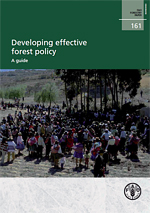
FAO Forestry Paper 161
Developing effective forest policy - A guide
Food and Agriculture Organization of the United Nations, Rome 2010
 |
FAO Forestry Paper 161Developing effective forest policy - A guideFood and Agriculture Organization of the United Nations, Rome 2010 |
The designations employed and the presentation of material in this information product do not imply the expression of any opinion whatsoever on the part of the Food and Agriculture Organization of the United Nations (FAO) concerning the legal or development status of any country, territory, city or area or of its authorities, or concerning the delimitation of its frontiers or boundaries. The mention of specific companies or products of manufacturers, whether or not these have been patented, does not imply that these have been endorsed or recommended by FAO in preference to others of a similar nature that are not mentioned.
ISBN 978-92-5-106607-2
All rights reserved. Reproduction and dissemination of material in this information product for educational or other non-commercial purposes are authorized without any prior written permission from the copyright holders provided the source is fully acknowledged. Reproduction of material in this information product for resale or other commercial purposes is prohibited without written permission of the copyright holders. Applications for such permission should be addressed to the Chief, Electronic Publishing Policy and Support Branch, Communication Division, FAO, Viale delle Terme di Caracalla, 00153 Rome, Italy or by e-mail to copyright@fao.org
© FAO 2010
(Download complete version ![]() - 1,9 MB)
- 1,9 MB)
Foreword
Acknowledgements
Summary: Ten things to know about forest policy
(Download ![]() - 272 KB)
- 272 KB)
1. Introduction (Download ![]() - 263 KB)
- 263 KB)
Background
Purpose of the guide
2. What is a national forest policy? (Download ![]() - 333 KB)
- 333 KB)
What is a national forest policy and why should a country have one?
What do national forest policies look like?
How does a forest policy relate to forest laws, national forest programmes, strategies and action plans?
How does a national forest policy link to other policies?
3. Policy development in a dynamic environment (Download ![]() - 102 KB)
- 102 KB)
What has changed in policy development?
Clarifying when a change is needed – and possible
4. Getting started: first steps in policy development (Download ![]() - 101 KB)
- 101 KB)
Planning, capacity building and communication
Preparatory analysis: providing key background information
High-level political leadership and administration support
Determining who should be involved and how, and the type of support needed
Guiding and managing the process: steering body and management team
5. Developing an agreement through dialogue and negotiation (Download ![]() - 297 KB)
- 297 KB)
Stakeholder discussions and consultation at the local, regional and national levels
Developing an agreement on goals, objectives and their implementation
Drafting a forest policy statement
Stakeholder validation of the draft forest policy
6. Preparing adoption and implementation of the forest policy (Download ![]() - 300 KB)
- 300 KB)
7. Conclusions and outlook (Download ![]() - 51 KB)
- 51 KB)
References (Download ![]() - 50 KB)
- 50 KB)
Annex 1: Examples of Tables of Contents of forest policy statements (Download ![]() - 51 KB)
- 51 KB)
Annex 2: Examples of vision or goal statements and principles (Download ![]() - 59 KB)
- 59 KB)
Annex 3: Further reading (Download ![]() - 189 KB)
- 189 KB)